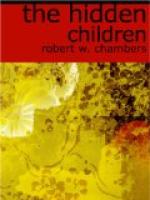When, later, we passed Yokam’s Place, we were fairly facing that vast solitude of twilight which lay between us and the main army’s outposts at the mouth of the Tioga. Except for a very few places on the Ouleout, and the Iroquois towns, the region was uninhabited. But the forest was beautiful after its own somewhat appalling fashion, which was stupendous, majestic, and awe-inspiring to the verge of apprehension.
Under these limitless lanes of enormous trees no sunlight fell, no underbrush grew. All was still and vague and dusky as in pillared aisles. There were no birds, no animals, nothing living except the giant columns which bore a woven canopy of leaves so dense that no glimmer of blue shone through. Centuries had spread the soundless carpet that we trod; eons had laid up the high-sprung arches which vanished far above us where vault and column were dimly merged, losing all form in depthless shadow.
There was an Indian path all the way from the lake, good in places, in others invisible. We did not use it, fearing an ambush.
The Mohican led us; I followed him; the last Oneida marked the trees for a new and better trail, and a straighter one not following every bend in the river. And so, in silence we moved southward over gently sloping ground which our wagons and artillery might easily follow while the batteaux fell down the river and our infantry marched on either bank, using the path where it existed.
Toward ten o’clock we came within sound of the river again, its softly rushing roar filling the woods; and after a while, far through the forest dusk, we saw the thin, golden streak of sunlight marking its lonely course.
The trail that the Mohican now selected swung ever nearer to the river, and at last, we could see low willows gilded by the sun, and a patch of blue above, and a bird flying.
Treading in file, rifles at trail, and knife and hatchet loosened, we moved on swiftly just within that strip of dusk that divides the forest from the river shrub; and I saw the silver water flowing deep and smooth, where batteaux as well as canoes might pass with unvexed keels; and, over my right shoulder, above the trees, a baby peak, azure and amethyst in a cobalt sky; and a high eagle soaring all alone.
The Mohican had halted; an Oneida ran down to the sandy shore and waded out into mid-stream; another Oneida was peeling a square of bark from a towering pine. I rubbed the white square dry with my sleeve, and with a wood-coal from my pouch I wrote on it:
“Ford, three feet at low water.”
The Stockbridge Indian who had stepped behind a river boulder and laid his rifle in rest across the top, still stood there watching the young Oneida in midstream who, in turn, was intently examining the river bank opposite.
Nothing stirred there, save some butterflies whirling around each other over a bed of purple milkweed, but we all watched the crossing, rifles at a ready, as the youthful Oneida waded slowly out into the full sunshine, the spray glittering like beaded topazes on his yellow paint.




